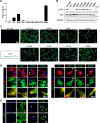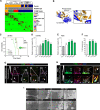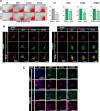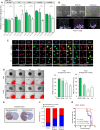Mutation-specific non-canonical pathway of PTEN as a distinct therapeutic target for glioblastoma
- PMID: 33828082
- PMCID: PMC8027895
- DOI: 10.1038/s41419-021-03657-0
Mutation-specific non-canonical pathway of PTEN as a distinct therapeutic target for glioblastoma
Abstract
PTEN is one of the most frequently altered tumor suppressor genes in malignant tumors. The dominant-negative effect of PTEN alteration suggests that the aberrant function of PTEN mutation might be more disastrous than deletion, the most frequent genomic event in glioblastoma (GBM). This study aimed to understand the functional properties of various PTEN missense mutations and to investigate their clinical relevance. The genomic landscape of PTEN alteration was analyzed using the Samsung Medical Center GBM cohort and validated via The Cancer Genome Atlas dataset. Several hotspot mutations were identified, and their subcellular distributions and phenotypes were evaluated. We established a library of cancer cell lines that overexpress these mutant proteins using the U87MG and patient-derived cell models lacking functional PTEN. PTEN mutations were categorized into two major subsets: missense mutations in the phosphatase domain and truncal mutations in the C2 domain. We determined the subcellular compartmentalization of four mutant proteins (H93Y, C124S, R130Q, and R173C) from the former group and found that they had distinct localizations; those associated with invasive phenotypes ('edge mutations') localized to the cell periphery, while the R173C mutant localized to the nucleus. Invasive phenotypes derived from edge substitutions were unaffected by an anti-PI3K/Akt agent but were disrupted by microtubule inhibitors. PTEN mutations exhibit distinct functional properties regarding their subcellular localization. Further, some missense mutations ('edge mutations') in the phosphatase domain caused enhanced invasiveness associated with dysfunctional cytoskeletal assembly, thus suggesting it to be a potent therapeutic target.
Conflict of interest statement
The authors declare no competing interests.
Figures






Similar articles
-
Correction of PTEN mutations in glioblastoma cell lines via AAV-mediated gene editing.PLoS One. 2017 May 2;12(5):e0176683. doi: 10.1371/journal.pone.0176683. eCollection 2017. PLoS One. 2017. PMID: 28464039 Free PMC article.
-
Impact of novel PTEN mutations in Turkish patients with glioblastoma multiforme.J Neurooncol. 2007 May;82(3):263-9. doi: 10.1007/s11060-006-9293-z. Epub 2006 Dec 7. J Neurooncol. 2007. PMID: 17151929
-
Molecular dynamic simulation and functional analysis of pathogenic PTEN mutations in glioblastoma.J Biomol Struct Dyn. 2023;41(21):11471-11483. doi: 10.1080/07391102.2022.2162582. Epub 2023 Jan 2. J Biomol Struct Dyn. 2023. PMID: 36591942
-
PTEN: one gene, many syndromes.Hum Mutat. 2003 Sep;22(3):183-98. doi: 10.1002/humu.10257. Hum Mutat. 2003. PMID: 12938083 Review.
-
PTEN signaling pathways in glioblastoma.Cancer Biol Ther. 2008 Sep;7(9):1321-5. doi: 10.4161/cbt.7.9.6954. Epub 2008 Sep 8. Cancer Biol Ther. 2008. PMID: 18836294 Review.
Cited by
-
Tau Protein as Therapeutic Target for Cancer? Focus on Glioblastoma.Cancers (Basel). 2022 Nov 1;14(21):5386. doi: 10.3390/cancers14215386. Cancers (Basel). 2022. PMID: 36358803 Free PMC article. Review.
-
Integration analysis of single-cell and spatial transcriptomics reveal the cellular heterogeneity landscape in glioblastoma and establish a polygenic risk model.Front Oncol. 2023 Jun 15;13:1109037. doi: 10.3389/fonc.2023.1109037. eCollection 2023. Front Oncol. 2023. PMID: 37397378 Free PMC article.
-
Unexplained Causes of Glioma-Associated Epilepsies: A Review of Theories and an Area for Research.Cancers (Basel). 2023 Nov 22;15(23):5539. doi: 10.3390/cancers15235539. Cancers (Basel). 2023. PMID: 38067243 Free PMC article. Review.
-
A tumor microenvironment model for glioma diagnosis and therapeutic evaluation based on the analysis of tissues and biological fluids.iScience. 2025 Jun 13;28(7):112881. doi: 10.1016/j.isci.2025.112881. eCollection 2025 Jul 18. iScience. 2025. PMID: 40655095 Free PMC article.
-
Anticancer effect of the oncolytic Newcastle disease virus harboring the PTEN gene on glioblastoma.Oncol Lett. 2024 Oct 16;29(1):6. doi: 10.3892/ol.2024.14752. eCollection 2025 Jan. Oncol Lett. 2024. PMID: 39492938 Free PMC article.
References
Publication types
MeSH terms
Substances
LinkOut - more resources
Full Text Sources
Other Literature Sources
Research Materials
Miscellaneous

